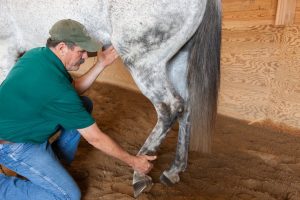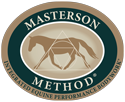
Have you ever noticed in training that it is often easier to do lateral work, bending, turning, and lead changes, in one direction than in the other? This may be due in part to a horse’s natural predominance of one side; what is sometimes called, “natural crookedness.” Horses are similar to humans in this respect. Between 85% and 90% of humans are naturally right-handed. In performance horses, we find the numbers to be comparable. Horses have an extra set of legs, so that this predominance shows up in diagonal pairs.
We find that the majority of horses to be what we call, “right front – left hind horses.” They put more load or stress on the right front – left hind diagonal. They are naturally a little more comfortable on the left lead and bending and turning to the left. To explain this further, try this example yourself: Stand up and “canter” around on one lead and then the other. Most likely, your left “lead” will be more comfortable if you are right handed.
Over time, in “right front – left hind” horses, the strain radiates upward from the right front foot and leg, showing up as tension in the right side of the poll and stiffness in the right side of the upper neck. Consequently, the stress generated from the left hind foot and leg radiates upward ending up as tightness in the left hindquarters, the sacrum, gluteal and hamstrings. This predominance and tension may be stronger in some horses, and less so in others.
We originally thought that this tension could be learned behavior due to handling the horse from an early age predominantly from the left side, and riding him with stronger hands, predominantly on the right. These conclusions changed when we came across young horses straight out of the pasture, as well as horses that were rarely ridden. The majority of these horses fit the above “right front-left hind” description.
“Why is this important in the training and performance of the horse?” you might ask. Often this natural imbalance can be worked through with training, by strengthening and conditioning the weaker diagonal, and suppling the stronger diagonal pair. However, if you are having consistent training problems, your horse may be trying to tell you that there are physical problems showing up that are associated with this natural imbalance.
If your horse continues to send signals that something is wrong, the first thing to do is to have the possibility of injury or impending injury ruled out by a veterinarian. We have noticed over the years that the majority of horses, in general, are frequently treated for right front and/or left hind, lower leg issues. Strange coincidence?
Once a veterinary or foot issue is ruled out or treated, and the horse is still telling you that something is not right in his world, the next place to look is in the body. This asymmetric tension itself can create problems as it escalates to a higher and higher degree. In this case it will make both your job, and your horse’s job easier if you do something to release tension and alleviate the soreness as it shows up in training, rather than trying to push through it. By working with the horse’s body and relieving the residual stress, the horse can come back into work a happier and freely moving partner.
By not listening to your horse, the stresses can evolve into something serious and inevitably give you more trouble down the road.
Complimentary sports therapies are important for equine athletes as they are for human athletes. Human athletes (or their highly paid agents) can speak up when pain or stiffness shows up in their performance, whereas the equine athlete has only you for his agent. In both cases, in the long term, it pays to listen to your client earlier than later and have ready at your disposal a bodywork regime to alleviate stress before it becomes a problem and sidelines you both.
If you are new to The Masterson Method and would like to know more about how to connect with your horse, you can learn all of the techniques in the Beyond Horse Massage Book and DVD set available on our store.
